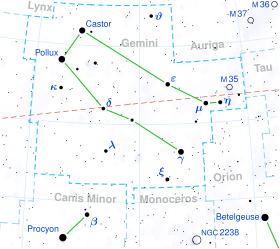astro.wikisort.org - Star
3 Geminorum is a blue supergiant star in the constellation Gemini. It is a small amplitude pulsating variable and a close double star, with a mean combined apparent visual magnitude of about 5.7.
![A light curve for PU Geminorum, plotted from Hipparcos data[9]](http://upload.wikimedia.org/wikipedia/commons/thumb/0/0f/PUGemLightCurve.png/220px-PUGemLightCurve.png)
| Observation data Epoch J2000.0 Equinox J2000.0 (ICRS) | |
|---|---|
| Constellation | Gemini |
| Right ascension | 06h 09m 43.9853s[1] |
| Declination | +23° 06′ 48.472″[1] |
| Apparent magnitude (V) | 5.71 - 5.77[2] |
| Characteristics | |
| Spectral type | B3Ia[3] |
| U−B color index | −0.63[4] |
| B−V color index | +0.21[4] |
| Variable type | α Cyg[5][2] |
| Astrometry | |
| Radial velocity (Rv) | 16.00±4.3[6] km/s |
| Proper motion (μ) | RA: −0.064[1] mas/yr Dec.: −2.685[1] mas/yr |
| Parallax (π) | 0.3878 ± 0.0616 mas[1] |
| Distance | approx. 8,000 ly (approx. 2,600 pc) |
| Absolute magnitude (MV) | −6.26[7] |
| Details | |
| Mass | 21[7] M☉ |
| Radius | 55[8] R☉ |
| Luminosity | 204,000[8] L☉ |
| Surface gravity (log g) | 2.45[8] cgs |
| Temperature | 16,500[8] K |
| Rotational velocity (v sin i) | 80[8] km/s |
| Other designations | |
| Database references | |
| SIMBAD | data |
3 Geminorum was found to be an α Cygni variable in 1998 and given the designation PU Geminorum. It varies by a few tenths of a magnitude[5] with a main period of 6.807 days[2] and a secondary period of 25 days.[8]
3 Geminorum is also a close double star. The brighter component is the variable blue supergiant. The companion is 2.5 magnitudes fainter. The separation is about 0.6 arc-seconds.[10] There is also a much fainter, approximately 14th magnitude, star 14" away.[11]
Faint Hα emission lines have been detected in the spectrum of 3 Geminorum,[12] but this is not usually expressed in published spectral classifications.[3] An "e" is only occasionally appended to the spectral type to reflect the emission lines.[13][5] 3 Geminorum has frequently been classified as a normal supergiant (luminosity class Ib),[14] although although a bright supergiant (Ia) luminosity class is now preferred.[3]
3 Geminorum can be occulted by the Moon. Observations of these occultations can give information about the angular diameter of a star, or about close companions. Occultations of 3 Geminorum have been observed, but no double or diameter information has been published.[15]
References
- Brown, A. G. A.; et al. (Gaia collaboration) (2021). "Gaia Early Data Release 3: Summary of the contents and survey properties". Astronomy & Astrophysics. 649: A1. arXiv:2012.01533. Bibcode:2021A&A...649A...1G. doi:10.1051/0004-6361/202039657. S2CID 227254300. (Erratum: doi:10.1051/0004-6361/202039657e). Gaia EDR3 record for this source at VizieR.
- "PU Gem". Variable Star Index. Retrieved 2022-05-22.
- Herman, R. (1973). "Classification des éTOILES B à Partir des Raises de l'HYDROGèNE-COMPARAISON avec d'Autres Classificaitons". Spectral Classification and Multicolour Photometry. 50: 17. Bibcode:1973IAUS...50...17H. doi:10.1007/978-94-010-2627-7_3. ISBN 978-94-010-2629-1.
- Ducati, J. R. (2002). "VizieR Online Data Catalog: Catalogue of Stellar Photometry in Johnson's 11-color system". CDS/ADC Collection of Electronic Catalogues. 2237. Bibcode:2002yCat.2237....0D.
- Samus, N. N.; Durlevich, O. V.; et al. (2009). "VizieR Online Data Catalog: General Catalogue of Variable Stars (Samus+ 2007-2013)". VizieR On-line Data Catalog: B/GCVS. Originally Published in: 2009yCat....102025S. 1. Bibcode:2009yCat....102025S.
- Gontcharov, G. A. (2006). "Pulkovo Compilation of Radial Velocities for 35 495 Hipparcos stars in a common system". Astronomy Letters. 32 (11): 759–771. arXiv:1606.08053. Bibcode:2006AstL...32..759G. doi:10.1134/S1063773706110065. S2CID 119231169.
- Searle, S. C.; Prinja, R. K.; Massa, D.; Ryans, R. (2008). "Quantitative studies of the optical and UV spectra of Galactic early B supergiants. I. Fundamental parameters". Astronomy and Astrophysics. 481 (3): 777. arXiv:0801.4289. Bibcode:2008A&A...481..777S. doi:10.1051/0004-6361:20077125. S2CID 1552752.
- Haucke, M.; et al. (June 2018). "Wind properties of variable B supergiants. Evidence of pulsations connected with mass-loss episodes". Astronomy & Astrophysics. 614: 28. arXiv:1902.01341. Bibcode:2018A&A...614A..91H. doi:10.1051/0004-6361/201731678. A91.
- "Hipparcos Tools Interactive Data Access". Hipparcos. ESA. Retrieved 8 December 2021.
- Roberts, Lewis C.; Turner, Nils H.; Bradford, L. William; Ten Brummelaar, Theo A.; Oppenheimer, Ben R.; Kuhn, Jeff R.; Whitman, Kathryn; Perrin, Marshall D.; Graham, James R. (2005). "Adaptive Optics Photometry and Astrometry of Binary Stars". The Astronomical Journal. 130 (5): 2262. Bibcode:2005AJ....130.2262R. doi:10.1086/491586.
- Mason, Brian D.; Wycoff, Gary L.; Hartkopf, William I.; Douglass, Geoffrey G.; Worley, Charles E. (2001). "The 2001 US Naval Observatory Double Star CD-ROM. I. The Washington Double Star Catalog". The Astronomical Journal. 122 (6): 3466. Bibcode:2001AJ....122.3466M. doi:10.1086/323920.
- Rosendhal, J. D. (1973). "A survey of H-alpha emission in early-type high-luminosity stars". Astrophysical Journal. 186: 909. Bibcode:1973ApJ...186..909R. doi:10.1086/152555.
- Kohoutek, L.; Wehmeyer, R. (1999). "Catalogue of H-alpha emission stars in the Northern Milky Way". Astronomy and Astrophysics Supplement. 134 (2): 255. Bibcode:1999A&AS..134..255K. doi:10.1051/aas:1999101.
- Skiff, B. A. (2014). "VizieR Online Data Catalog: Catalogue of Stellar Spectral Classifications (Skiff, 2009-2016)". VizieR On-line Data Catalog: B/Mk. Originally Published in: Lowell Observatory (October 2014). 1. Bibcode:2014yCat....1.2023S.
- Meyer, C.; Rabbia, Y.; Froeschle, M.; Helmer, G.; Amieux, G. (1995). "Observations of lunar occultations at Observatoire de la Cote d'Azur". Astronomy and Astrophysics Supplement. 110: 107. Bibcode:1995A&AS..110..107M.
На других языках
- [en] 3 Geminorum
[ru] 3 Близнецов
3 Близнецов (лат. 3 Geminorum), PU Близнецов (лат. PU Geminorum), HD 42087 — тройная звезда в созвездии Близнецов на расстоянии приблизительно 6 765 световых лет (около 2 075 парсек) от Солнца.Другой контент может иметь иную лицензию. Перед использованием материалов сайта WikiSort.org внимательно изучите правила лицензирования конкретных элементов наполнения сайта.
WikiSort.org - проект по пересортировке и дополнению контента Википедии
